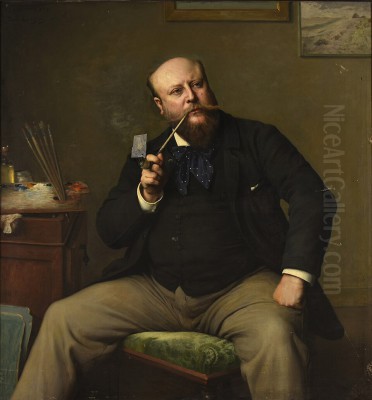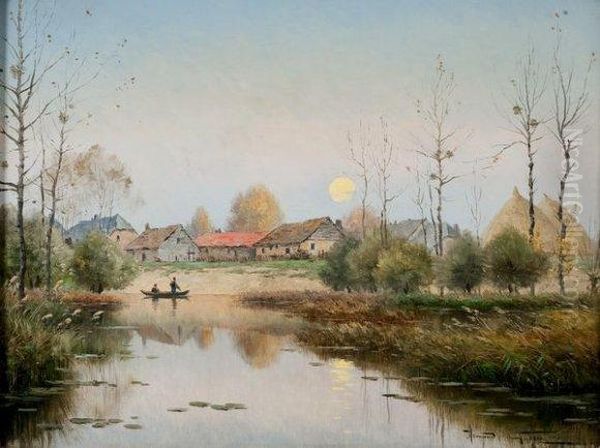
Armand Guéry (1850-1912) stands as a significant, if sometimes overlooked, figure in late 19th and early 20th-century French landscape painting. His work, deeply rooted in the observation of nature, captured the diverse beauty of the French countryside, from the rolling plains of Champagne to the majestic peaks of the Alps. Guéry skillfully navigated the artistic currents of his time, blending a Romantic sensibility for the sublime in nature with an Impressionistic fascination for light and atmosphere, leaving behind a legacy of evocative and meticulously rendered scenes.
Early Life and Artistic Awakening in Reims
Born in Reims on March 4, 1850, Armand Guéry grew up in a region renowned for its Champagne vineyards. His father, a wine broker, provided a comfortable bourgeois upbringing. The young Guéry completed his secondary education before undertaking his compulsory military service, a common path for young men of his era. It was after this period that his artistic inclinations began to take firm shape.
His formal artistic training commenced under the tutelage of Auguste Gouzi, a local painter from Reims. Under Gouzi's guidance, Guéry honed his foundational skills, learning the importance of direct observation and the techniques required to translate the natural world onto canvas. This early instruction emphasized a faithful representation of nature, a principle that would remain central to Guéry's artistic philosophy throughout his career, even as he incorporated more contemporary approaches to light and color. He quickly developed a passion for landscape, spending considerable time outdoors, sketching and painting en plein air, a practice popularized by the Barbizon School painters like Théodore Rousseau and Charles-François Daubigny.
Travels and the Shaping of a Landscape Vision
Guéry's artistic development was profoundly influenced by his travels. He was not content to merely depict the familiar landscapes of his native Champagne. Instead, he sought out diverse terrains, each offering unique challenges and inspirations. He journeyed extensively through the Pyrenees, the French and Swiss Alps, and Italy, regions that had captivated landscape artists for generations, from the Romantic evocations of J.M.W. Turner to the more structured compositions of earlier masters.

These expeditions provided him with a rich palette of subjects. The rugged grandeur of the mountains, the serene beauty of alpine lakes, and the picturesque charm of Italian villages all found their way into his sketchbooks and canvases. His travels through the Ardennes, particularly along the Semois River, were especially fruitful. The unique rock formations and verdant valleys of this region became recurring motifs in his work, allowing him to explore textures, light, and atmospheric effects with remarkable sensitivity. This dedication to capturing specific regional characteristics aligns him with other landscape specialists of the era who sought to document the diverse beauty of their homelands.
Artistic Style: A Synthesis of Tradition and Modernity
Armand Guéry's artistic style is characterized by a delicate balance between traditional landscape conventions and the burgeoning modernism of the late 19th century. His work often exhibits the meticulous detail and compositional structure inherited from the academic tradition, yet it is infused with a sensitivity to light and atmosphere that echoes the innovations of Impressionism.
His brushwork, while often fine and controlled, could also become more expressive when capturing the fleeting effects of light or the textures of natural elements like rock and foliage. He possessed a keen eye for color, employing a rich and nuanced palette to convey the specific mood and time of day of his scenes. Unlike some of his Impressionist contemporaries, such as Claude Monet or Camille Pissarro, who prioritized the subjective experience of light and often dissolved form, Guéry maintained a stronger sense of structure and local color. However, the influence of Impressionism is undeniable in his attempts to capture the transient qualities of light and its impact on the landscape.
His paintings often evoke a sense of tranquility and a deep appreciation for the natural world, aligning with the Romantic sentiment that saw nature as a source of spiritual solace and sublime beauty. Yet, his objective observation and careful rendering of specific locales also place him within the realist tradition that valued truth to nature above idealized representation. This synthesis made his work accessible and appealing to a broad audience.
Key Works and Thematic Focus
Armand Guéry's oeuvre is rich with depictions of the French landscape, but certain works and regions stand out.
His paintings of the Champagne region, such as "La Grande Plaine de Champagne" (The Great Plain of Champagne), showcased his ability to capture the expansive, rolling vistas of his homeland. These works often emphasize the subtle interplay of light and shadow across the fields, conveying a sense of peace and agricultural abundance.
The Ardennes, particularly the area around the Semois River, provided him with dramatic and picturesque subjects. "Rochers de la Semois" (Rocks of the Semois) is a prime example, where he masterfully renders the rugged texture of the rock formations and the reflective qualities of the water. Another significant work from this period is "Paysage de la Vesle à Sept-Saulx" (Landscape of the Vesle at Sept-Saulx), which further demonstrates his commitment to capturing the specific character of the Champagne-Ardenne landscapes.
His travels to the Alps resulted in majestic mountain scenes, where he conveyed both the grandeur and the delicate atmospheric conditions of high altitudes. These works often feature snow-capped peaks, clear alpine lakes, and dramatic cloud formations, showcasing his skill in rendering diverse natural phenomena. He shared this passion for mountain scenery with artists like Laurent Guétal, who also specialized in alpine landscapes.
A notable work that demonstrates his versatility is "Promenade en barque," also known as "On the Thames" or "A Boating Trip." This painting, depicting a leisurely scene on the River Thames in London, shows his ability to capture urban landscapes and waterscapes with the same sensitivity to light and atmosphere that he applied to rural French scenes. The soft, diffused light often characteristic of the London atmosphere is skillfully rendered, creating a charming and evocative image.
Recognition: The Paris Salon and Artistic Societies
Armand Guéry actively sought recognition for his work through the established channels of the Parisian art world, most notably the Paris Salon. The Salon, organized by the Académie des Beaux-Arts, was the premier art exhibition in France and crucial for an artist's career progression.
He achieved considerable success at the Salon. His painting "La Grande Plaine de Champagne" was exhibited in 1880, marking a significant step in his career. Over the years, he received several accolades: an honorable mention in 1885, a third-class medal in 1896, and a second-class medal in 1894. In 1900, he was awarded an American honorable mention, indicating that his reputation was beginning to extend beyond France. These awards, in an era when the Salon was still a dominant force, despite the rise of independent exhibitions by groups like the Impressionists, were testaments to his skill and the appeal of his work. He exhibited alongside many famous contemporaries, from academic masters like William-Adolphe Bouguereau and Jean-Léon Gérôme to other landscape painters who were pushing boundaries, such as Alfred Sisley.
Beyond the Salon, Guéry was an active participant in the artistic community. In 1879, his two important landscapes, "Rochers de la Semois" and "Paysage de la Vesle à Sept-Saulx," were exhibited at the Reims Artists' Society, where they received positive recognition. A particularly significant contribution was his role as a co-founder of the Société des Peintres de Montagne (Society of Mountain Painters) in 1898. This society brought together artists who specialized in depicting mountain landscapes, including figures like Franz Schrader and Henry Béraldi, fostering a community dedicated to this challenging and inspiring genre. His involvement underscores his deep commitment to landscape painting and his desire to promote this specific niche.
In 1906, his contributions to art and culture were further recognized when he was made an honorary member of the Agricultural, Commercial, and Artistic Society of Marne, a testament to his standing in his home region.
The Parisian Art Scene and Contemporaries
Guéry operated within a vibrant and rapidly evolving Parisian art scene. The late 19th century was a period of immense artistic ferment, with traditional academic art coexisting, often uneasily, with revolutionary movements like Impressionism and Post-Impressionism. While Guéry was not an avant-garde radical, his work reflects an awareness of these new artistic currents, particularly in his treatment of light.
He would have been aware of the groundbreaking work of Impressionists like Claude Monet, Edgar Degas, and Pierre-Auguste Renoir, who challenged academic conventions with their focus on fleeting moments, contemporary life, and the subjective perception of light and color. While Guéry's style remained more grounded in representational accuracy, the Impressionists' emphasis on plein air painting and capturing atmospheric effects undoubtedly resonated with his own landscape practice.
The Barbizon School painters, such as Jean-Baptiste-Camille Corot, Jean-François Millet, and Théodore Rousseau, had earlier paved the way for a greater appreciation of naturalistic landscape painting, moving away from idealized classical landscapes. Guéry's dedication to depicting specific French locales with truthfulness can be seen as an extension of their legacy.
His involvement with the Société des Peintres de Montagne also connected him with a specialized group of artists who shared his passion for alpine scenery. This society provided a platform for artists focused on a genre that required not only artistic skill but also a degree of physical hardiness to access and sketch remote mountain locations.
Personal Life: Triumphs and Tribulations
While Armand Guéry's professional life was marked by steady achievement and recognition, his personal life appears to have had its share of difficulties. He married Marie Tourcat, but the union eventually ended in divorce in 1900. Such personal upheavals, while not uncommon, would undoubtedly have impacted his life and perhaps his work, though specific connections are not well documented.
He owned a property in Paris known as the "Villa des Fleurs." This residence, likely a testament to his success as an artist, was unfortunately destroyed during the First World War, a conflict that reshaped Europe and brought an end to the Belle Époque era in which Guéry had flourished. This loss, though posthumous to Guéry himself, represents a poignant destruction of a part of his material legacy.
Armand Guéry passed away in Paris on May 25, 1912. He was buried in the North Cemetery in his hometown of Reims, returning to the region that had first inspired his artistic journey.
Legacy and Conclusion
Armand Guéry's legacy is that of a dedicated and highly skilled landscape painter who captured the diverse beauty of France with sensitivity and precision. He successfully navigated the artistic landscape of his time, creating works that appealed to both traditional tastes and those who appreciated the newer approaches to light and atmosphere. While perhaps not as revolutionary as some of his contemporaries, his contribution to French landscape painting is significant.
His paintings serve as valuable historical and artistic records of the French countryside at the turn of the 20th century. They reflect a deep love for nature and a mastery of technique that allowed him to convey its many moods and facets. His involvement in artistic societies, particularly the Société des Peintres de Montagne, highlights his commitment to his craft and his peers.
Though detailed anecdotes or extensive personal records about Guéry are not widely prevalent, his extensive body of work speaks volumes. His paintings invite viewers to appreciate the serene beauty of the Semois valley, the expansive plains of Champagne, the majestic Alps, and even the gentle charm of a boat ride on the Thames. Armand Guéry remains a noteworthy artist whose canvases continue to offer a window into the natural world as seen through the eyes of a talented and devoted observer, a quiet master of French landscape. His art provides a bridge between the Romantic reverence for nature and the modern exploration of light, securing his place in the rich tapestry of 19th-century European art.